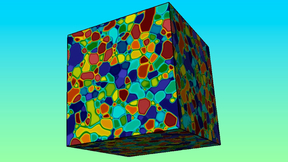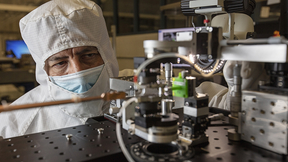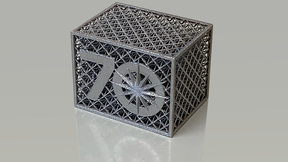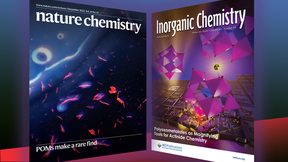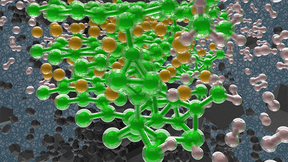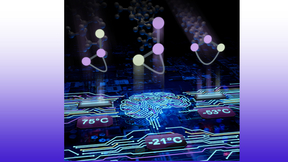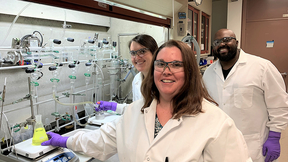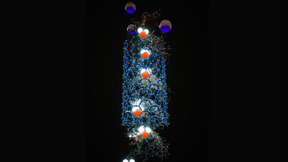Back
Advanced Materials and Manufacturing
Understanding material degradation in titanium alloys
Titanium (Ti) and its alloys are attractive for a wide variety of structural and functional applications due to the metal’s excellent strength, toughness and stiffness, and corrosion resistance. Specific applications include lightweight structural materials, bioimplants, and energy storage materials. However, if exposed to hydrogen sources, these alloys are susceptible to…
Target evolution is a key to LLNL's continued success
Part 8 in a series of articles describing the elements of Lawrence Livermore National Laboratory's fusion breakthrough. The intricate, delicate targets used in Lawrence Livermore National Laboratory (LLNL)’s National Ignition Facility (NIF) experiments are marvels of design, engineering and precise manufacturing. “We’ve been working over the last 16 years on continuously…
Ion–water clusters in carbon nanotubes
In 1888, Walther Nernst proposed a universal relation between a charged particle’s electrophoretic mobility (a solute’s velocity in response to an applied electric field) and its diffusion coefficient (the rate at which a particle free-diffuses through medium). The microscopic origins of this relation were revealed in 1905 by Albert Einstein. These works cemented the…
Characterizing the thermal expansion of ultra-high temperature ceramics
There is a growing interest in understanding the performance and properties that make ultra-high temperature ceramics (UHTCs) promising for extreme environment applications, such as hypersonic platforms, nuclear reactors, and atmospheric re-entry. UHTCs are inorganic materials that exhibit metallic conductivity with melting temperatures above 3000 °C. One such material,…
Four Lab postdocs selected to attend the 72nd annual Lindau Nobel Laureate meeting
Four Lawrence Livermore National Laboratory (LLNL) postdoctoral appointees have been selected to attend the 72nd annual Lindau Nobel Laureate meeting in Germany this summer thanks to the University of California President’s 2023 Lindau Nobel Laureate Meetings Fellows Program. The four selected to attend are Wonjin Choi, Sean Leonard, Sijia Huang and Sarah Sandholtz. The…
Fueling up hydrogen production
Through machine learning, a Lawrence Livermore National Laboratory (LLNL) scientist has a better grasp of understanding materials used to produce hydrogen fuel. Water is everywhere in the environment and its interaction with metal oxide surfaces has a key role in processes that range from wetting, dissolution and corrosion to photocatalytic reactions. The relative…
NIF’s optics meet the demands of increased laser energy
Part 5 in a series of articles describing the elements of Lawrence Livermore National Laboratory's fusion breakthrough. If Lawrence Livermore National Laboratory (LLNL)’s National Ignition Facility (NIF) were a race car, it would run at the redline most of the time. “NIF is the only laser system that intentionally operates above the laser damage growth threshold,” said…
Breaking it down, carbon nanotube style
When it comes to studying particles in motion, experimentalists have followed a 100-year-old theory that claims the microscopic motion of a particle is determined by random collisions with molecules of the surrounding medium, regardless of the macroscopic forces that drive that motion. Scientists at Lawrence Livermore National Laboratory (LLNL) and the Massachusetts…
Demonstrating energy-efficient conversion of nitrate pollutants into ammonia
The nitrate runoff problem, a source of carcinogens and a cause of suffocating algal blooms in U.S. waterways, may not be a harbinger of doom. A new study led by the University of Illinois Urbana-Champaign and researchers from Lawrence Livermore National Laboratory (LLNL) demonstrates an approach for the integrated capture and conversion of nitrate-contaminated waters into…
LLNL researchers develop method for real-time defect detection in metal 3D-printed parts
Lawrence Livermore National Laboratory (LLNL) engineers and scientists have developed a method for detecting and predicting strut defects in 3D-printed metal lattice structures during a print through a combination of monitoring, imaging techniques and multi-physics simulations. The high-strength and low-density properties of metallic lattices have found applications in…
Nanofluidic computing makes a splash
Neuromorphic computing aims to mimic the energy-efficient information processing of the human brain. To enable brain like processing, a new device architecture that forgoes the rigid computing language of zeros and ones is needed. This brings the question, what if devices used ions moving in fluids to carry and store information? MSD’s Alex Noy co-authored a perspective…
LLNL chemists double down with breakthrough method to study radioactive materials
Studying radioactive materials is notoriously difficult due to their radiation-induced toxicity and risk of contamination when handling. The cost of the radioactive isotopes used in research also is a major barrier, with some costing more than $10,000 per microgram. Certain radioisotopes also cannot be produced in sufficient quantity so it is simply impossible for…
Five Lab teams recognized with Secretary’s Honor Achievement Awards
Lawrence Livermore National Laboratory (LLNL) employees, participating in five project teams, recently earned Department of Energy (DOE) Secretary’s Honor Achievement Awards. Representing some of the highest internal, non-monetary recognition that DOE employees and contractors can receive, the Secretary’s Honor Awards recognize DOE employees and contractors for their…
Going small and thin for better hydrogen storage
A collaboration including scientists from Lawrence Livermore National Laboratory (LLNL), Sandia National Laboratories, the Indian Institute of Technology Gandhinagar and Lawrence Berkeley National Laboratory has created 3-4 nanometer ultrathin nanosheets of a metal hydride that increase hydrogen storage capacity. The research appears in the journal Small. There is a need…
Beating the odds: Former Energetic Materials Center intern named U.S. Air Force Cadet of the Year
Second Lt. Hannah Fletcher, a 2021 Lawrence Livermore National Laboratory (LLNL) Reserve Officer Training Corps (ROTC) summer intern, has been named the 2022 United States Air Force (USAF) Cadet of the Year. This award recognizes the best cadet in an Air Force commissioning program based on military performance, academics and physical fitness. LLNL’s ROTC internship…
LLNL scientist named to Forbes ’30 under 30’ list
Lawrence Livermore National Laboratory materials scientist Daniel Schwalbe-Koda has been named one of Forbes “30 under 30” for 2023 in the science category. Forbes features a list of 600 individuals under the age of 30 each year, who have impactful careers and/or accomplishments across a span of industries — healthcare, science, consumer technology, Hollywood, retail,…
Charging up with carbon nanotubes
Lawrence Livermore National Laboratory (LLNL) scientists have created vertically aligned single-walled carbon nanotubes on metal foils that could be a boon for energy storage and the electronics industry. Vertically aligned carbon nanotubes (VACNTs) have exceptional mechanical, electrical and transport properties in addition to an aligned architecture, which is key for…
Machine-learning model instantly predicts polymer properties
Hundreds of millions of tons of polymer materials are produced globally for use in a vast and ever-growing application space with new material demands such as green chemistry polymers, consumer packaging, adhesives, automotive components, fabrics and solar cells. But discovering suitable polymer materials for use in these applications lies in accurately predicting the…
Uranium takes an alternate pathway under extreme conditions
Under normal conditions, radioactive materials such as uranium work in a predictable manner. But take those same materials and put them under extreme conditions with high temperature in a short timescale and a rapid cooling process and their decomposition pathways change dramatically. Lawrence Livermore National Laboratory (LLNL) scientists built a unique process to…
LLNL to participate in three energy-focused projects
Transforming the way energy is collected, stored and used has become a defining challenge of the 21st century. To address this task, the Department of Energy’s (DOE) Office of Basic Energy Sciences (BES) established the Energy Frontier Research Center (EFRC) program. This year, Lawrence Livermore National Laboratory and collaborators were awarded three projects. The first…


